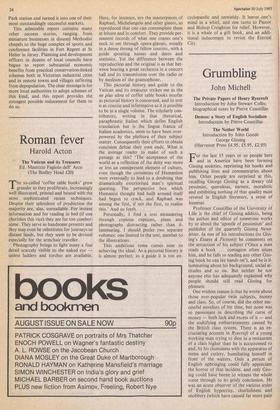Roman fever
Harold Acton
The Vatican and its Treasures Ed. Maurizio Fagiolo dell' Arco (The Bodley Head £20) 'The so-called 'coffee table books' grow grander as they proliferate, increasingly well illustrated, printed and bound with the most sophisticated recent techniques. Despite their splendour of production the majority are, alas, unreadable. For instant information and for reading in bed (if one cherishes this vice) they are far too cumber- some. They serve as handsome presents and they may even be substitutes for journeys to distant lands, but they seem to be devised especially for the armchair traveller.
Photography brings to light many a fine detail scarcely visible to the naked eye — unless ladders and torches are available. Here, for instance, are the masterpieces of Raphael, Michelangelo and other giants, so reproduced that one can contemplate them at leisure and in comfort. They provide per- manent records of what one cranes one's neck to see through opera-glasses, usually in a dense throng of fellow tourists, with a guide spouting names and dates and statistics. Yet the difference between the reproduction and the original is as that bet- ween hearing a great orchestra in a concert hall and its transmission over the radio or by medium of the gramophone.
This pictorial history and guide to the Vatican and its treasures strikes me as the ne plus ultra of coffee table books insofar as pictorial history is concerned, and its text is as concise and informative as it is possible to be in a single volume. The scholarly con- tributors, writing in that rhetorical, paraphrastic Italian which defies English translation but is the lingua franca of Italian academics, seem to have been over- powered by the plethora of their subject matter. Consequently their efforts to obtain concision defeat their own ends. What is the average reader to make of such a passage as this? 'The acceptance of the world as a reflection of the deity was more or less an omnipresent element of culture, even though the certainties of Humanism were eventually to lead to a doubting that dramatically exteriorised man's spiritual questing. The perspective box which Humanist thought had built around itself had begun to crack, and Raphael was among the first, if not the first, to realise this.' And so forth.
Personally, I find a text meandering through copious captions, plans and photographs distracting rather • than il- luminating. I should prefer two separate volumes: one limited to the text, another to the illustrations.
This ambitious tome comes near to achieving the ideal. As a pictorial history it is almost ,perfect; as a guide it is too en-
cyclopaedic and unwieldy. It leaves one's mind in a whirl, and one turns to Pastor and Bishop Creighton for relief. However, it is, a whale of a gift book, and an addi- tional inducemnt to revisit the Eternal City.






































 Previous page
Previous page